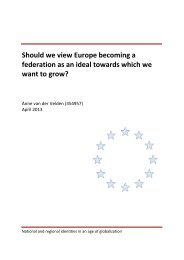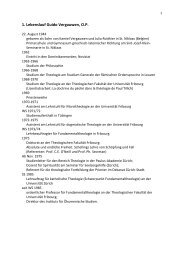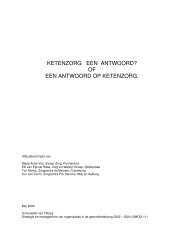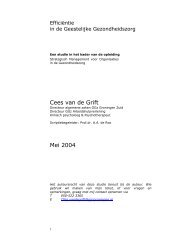Regulation of Transborder Data Flows under ... - Tilburg University
Regulation of Transborder Data Flows under ... - Tilburg University
Regulation of Transborder Data Flows under ... - Tilburg University
You also want an ePaper? Increase the reach of your titles
YUMPU automatically turns print PDFs into web optimized ePapers that Google loves.
Kuner/<strong>Regulation</strong> <strong>of</strong> <strong>Transborder</strong> <strong>Data</strong> <strong>Flows</strong> <strong>under</strong> <strong>Data</strong> Protection and Privacy Law 7<br />
However, little ‘hard’ research has been done to confirm the effects <strong>of</strong> transborder data<br />
flow regulation.<br />
Since one <strong>of</strong> the main motivations for transborder data flow regulation is the possibility<br />
that personal data may be transferred across national borders in order to circumvent legal<br />
protections, the need for such regulation is reduced to the extent that data protection and<br />
privacy law is harmonised. Nevertheless, for a variety <strong>of</strong> reasons, the likelihood that a<br />
legally-binding data protection instrument <strong>of</strong> global application will be enacted in the<br />
foreseeable future appears slim. In practice, the subjects <strong>of</strong> transborder data flow<br />
regulation and applicable law are <strong>of</strong>ten intertwined, and countries may use rules on<br />
applicable law to protect data transferred beyond their borders. In particular, data<br />
protection and privacy law may be applied to the processing <strong>of</strong> data transferred outside<br />
the country, thus using rules on applicable law to serve the same purpose as regulation <strong>of</strong><br />
transborder data flows. Rules on applicable law and jurisdiction with regard to data<br />
protection and privacy law are notoriously unclear, which can create problems in<br />
particular for individuals, who <strong>of</strong>ten may not be able to determine which law applies to<br />
the processing <strong>of</strong> their personal data, and to which national regulatory authorities they<br />
may turn if a problem arises.<br />
The following are some important issues requiring further attention:<br />
There is increasing tension between regulatory approaches based on geography (such as<br />
those dependent on the ‘adequacy’ <strong>of</strong> data protection in foreign jurisdictions) and those<br />
that are more organisationally-based (such as <strong>under</strong> the accountability principle). What is<br />
needed is a way for the geographical and organisational approaches to co-exist. One<br />
solution could be a mixture <strong>of</strong> the two approaches, i.e., organisationally-based<br />
approaches that allow geography to be considered in making decisions about whether the<br />
transfer <strong>of</strong> personal data abroad is appropriate. Increased cooperation between data<br />
protection and privacy regulators can help minimize the problems caused by differences<br />
in the approaches to transborder data flow regulation.<br />
There are two default positions in transborder data flow regulation, namely either<br />
presuming that data flows should be allowed, but leaving the possibility for regulators to<br />
block or limit them, or presuming that such flows should not take place unless a legal<br />
basis for the transfer is present. Neither <strong>of</strong> the two default positions seems inherently<br />
better than the other, each one has inherent advantages and disadvantages, and which one<br />
a country selects will largely depend on its own culture, history, and legal tradition.<br />
However, the position selected must be accompanied by measures to avoid its inherent<br />
disadvantages, otherwise the first position will tend to be too reactive, and the second one<br />
will be excessively bureaucratic.<br />
<strong>Regulation</strong> <strong>of</strong> transborder data flows was originally designed to prevent the<br />
circumvention <strong>of</strong> national data protection law. As the volume <strong>of</strong> transborder data flows<br />
has dramatically increased, the policies behind such regulation have shifted.<br />
Policymakers need to consider the rationales behind regulation <strong>of</strong> transborder data flows<br />
more closely. <strong>Transborder</strong> data flows should also be seen as a phenomenon that may<br />
bring both risks and benefits: while the transfer <strong>of</strong> personal data to countries with lower<br />
standards <strong>of</strong> protection may produce risks, the transfer to countries with higher standards

















